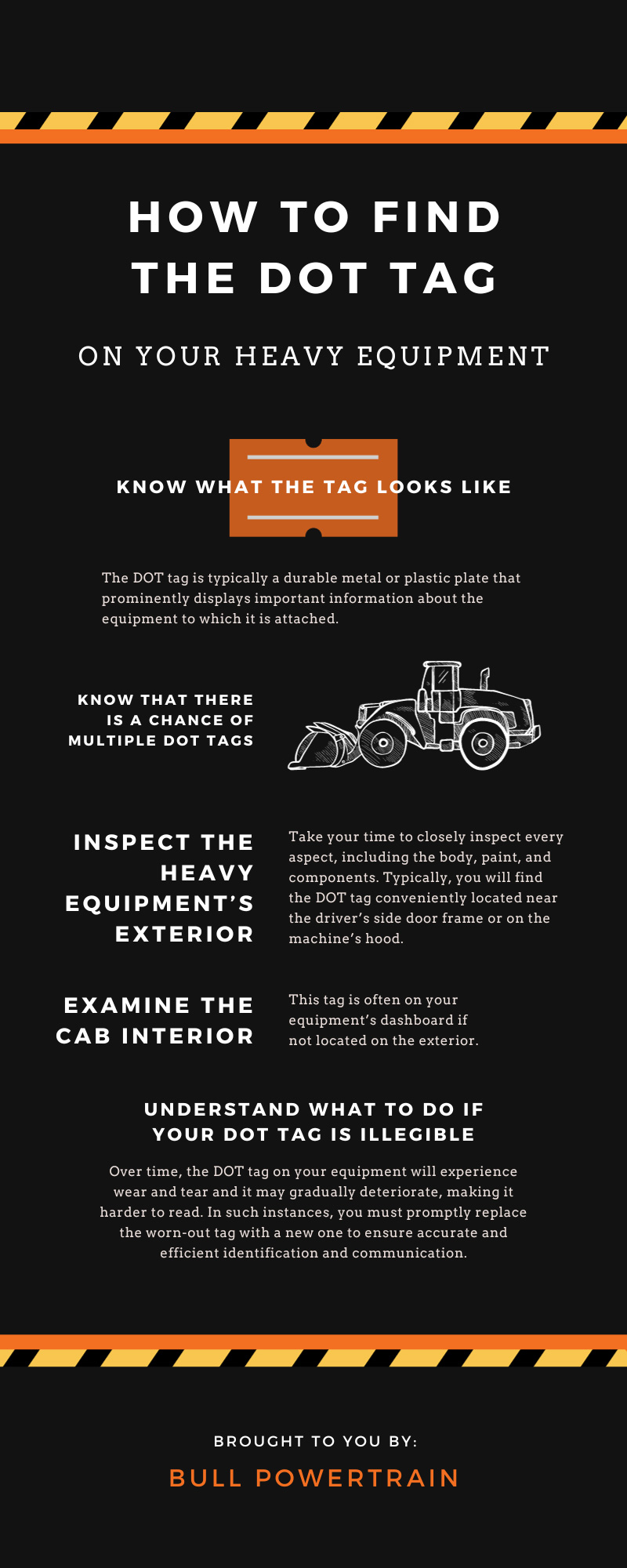The Department of Transportation (DOT) has specific rules and regulations when it comes to heavy equipment. To ensure the heavy equipment you’re using follows these rules, it must have DOT tags. Additionally, you need to know how to find the DOT tag on your heavy equipment.
Understand DOT Tag Importance
You may recognize that it’s important to know the location of the DOT tag, but why is this small bit of information so crucial? As previously mentioned, the Department of Transportation has very clear rules and regulations when it comes to vehicles and certain types of machinery. Specifically, the regulations regarding heavy equipment are in place to ensure operators remain safe and don’t end up damaging the roads or harming others in the vicinity.
Each DOT tag holds essential information about the machine it’s on, including the manufacturer, model number, and serial number. Additionally, the DOT tag displays important safety and compliance certifications, such as those pertaining to the Department of Transportation’s motor vehicle safety standards.
The DOT tag is also significant because it serves as irrefutable proof of ownership for your heavy equipment. In the event of an accident or theft, this tag aids authorities in identifying and reuniting you with your machine. The tag will also provide you with the information you need to get the right maintenance, repairs, and replacement parts for your unique machine.
Know What the Tag Looks Like
The DOT tag is typically a durable metal or plastic plate that prominently displays important information about the equipment to which it is attached. The tag’s information is often engraved or even stamped on, ensuring that it remains visible and will not rub off or fade over time.
Alternatively, the DOT tag can be in the form of a sticker, which offers a flexible and convenient option for displaying the required information on the machine. This versatility allows for easy placement and removal, ensuring compliance with regulations while accommodating various vehicle types and sizes.
Inspect the Heavy Equipment’s Exterior
If you want to find the DOT tag on your heavy equipment, you need to start by thoroughly examining your equipment’s exterior. Take your time to closely inspect every aspect, including the body, paint, and components. Typically, you will find the DOT tag conveniently located near the driver’s side door frame or on the machine’s hood.
While you’re looking for your DOT tag, be sure to also inspect your machine for signs of wear, damage, and corrosion. During these inspections, you can find your DOT tag and ensure that your heavy equipment is in optimal condition for operation.
Examine the Cab Interior
If you do not find your DOT tag in any of these locations, take a moment to carefully examine the interior of the cab. Look around the dashboard area and near the controls and gauges to find the DOT tag. This tag is often on your equipment’s dashboard if not located on the exterior.
Alternatively, it might be tucked away inside one of the various compartments or storage spaces within the cab. Take your time to thoroughly inspect these areas, and you may uncover the DOT tag.
Know That There Is a Chance of Multiple DOT Tags
In certain industries, it is not uncommon to find equipment with multiple DOT tags. These tags are specifically meant for different components or parts of the equipment, providing valuable information for inspection and ensuring compliance with regulations as they pertain to each part.
Even after finding one DOT tag, be sure to continue your inspection and search all the potential locations where these tags may be. When you find any and all DOT tags, you can ensure your heavy equipment is compliant and adheres to the highest standards of safety and regulatory requirements.
Consult the Owner’s Manual
If you are still unable to locate the DOT tag, take a moment to consult your owner’s manual for specific instructions. The owner’s manual is a valuable resource that usually contains detailed diagrams and explanations.
This manual can provide you with a comprehensive understanding of the various components of your device, making it easier for you to locate the specific tag you’re searching for. In addition to helping you find the DOT tags, the owner’s manual will also provide valuable insights into the equipment you’re using.
Understand What To Do if Your DOT Tag Is Illegible
Over time, the DOT tag on your equipment will experience wear and tear and it may gradually deteriorate, making it harder to read. In such instances, you must promptly replace the worn-out tag with a new one to ensure accurate and efficient identification and communication. Neglecting this crucial step may lead to unwanted delays, potential errors, or even compromised safety protocols.
Be sure to prioritize your DOT tag’s maintenance and cleaning so it can stay readable for as long as possible. A clear DOT tag is a critical component for seamless operations and overall effectiveness.
Know What To Do if Your Equipment Doesn’t Have a DOT Tag
If your heavy equipment came from outside of the United States, it may not feature a Department of Transportation tag. In such cases, it is important to look for a similar compliance label issued by the respective transportation department of the country where the equipment came from. This compliance label serves as a clear indication that the equipment meets the necessary safety and regulatory standards specific to that region.
By finding the DOT tag on your heavy equipment, you can keep track of your equipment’s specifications and ensure compliance with the applicable regulations. With this information, you can have peace of mind knowing that your heavy equipment operates within the required safety parameters.
At Bull Powertrain, we are prepared to answer any questions or concerns you may have regarding your equipment’s DOT tag. And with your tag information, we can get you the OEM powertrain parts you need for your machinery. We have everything you need to keep your equipment running efficiently, including heavy-duty axles you’ll have a hard time finding anywhere else. Our team of experts is always available to offer the best solutions and recommendations for your equipment needs.


